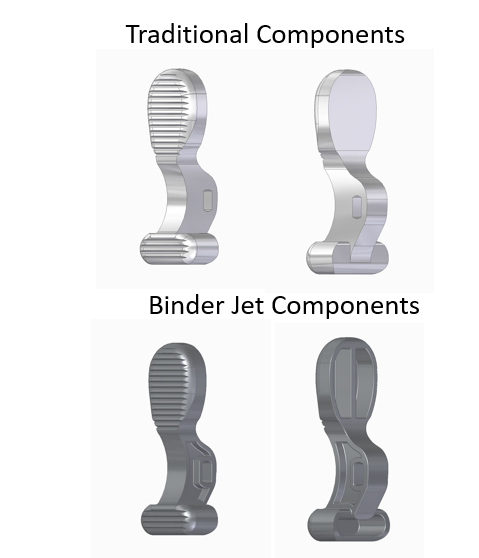.ashx?h=300&w=940&hash=3D5FF4C915640BB9CF9B70EB7AA0FF9E)
What is additive manufacturing? How does it impact metal?
In May 2022, Ryerson invested in FreeFORM Technologies, an additive manufacturing and engineering company specializing in metal additive manufacturing.
We sat down with Chris Aiello, FreeFORM’s co-founder, for a discussion on the topic of additive manufacturing and what it could mean for your next metal product.
What is additive manufacturing?
Before diving into the interview, let's start with a definition. Additive manufacturing is the process of creating an object by building it one layer at a time. It starts from a 3D model of a product, which is then translated into a layer-by-layer framework, and subsequently produced using an additive manufacturing machine.
This is the opposite of traditional manufacturing techniques in which material is removed to complete a part. Additive manufacturing is commonly referred to as 3D printing, but true additive manufacturing involves much more than a 3D print.
Additive manufacturing can be done using a range of different materials, including metal.
What value does additive manufacturing bring to the process?
Aiello: There is the freedom of what you can make with additive manufacturing because it eliminates some of the traditional limitations of part design, such as tooling or axis in a CNC machine.
A traditional investment casting or metal-injection molding tool can cost $50,000 and can take you 12-20 weeks before you see the initial parts. If we make a traditional metal-injection molding part with the metal additive process, we can deliver initial prototypes in 10 days.
This is where the lower total cost of ownership really resonates. Because we are delivering a prototype much quicker, the customer can begin the iteration process earlier and adjust for fit or function much sooner.
Is additive manufacturing a fit for all types of parts?
Aiello: As I like to describe it, we make parts that fit in your hand, not in a truck. We are focused on parts that are smaller than a volume of a softball.
A good rule of thumb is that if a product requires four axis or more, it is probably a good fit for additive manufacturing. Generally, anything that has an isometric view—where you can look at it in three views (front, side, and back) -- is not the best fit.
What are some examples?
Aiello: Some of the most common uses of additive manufacturing today include medical devices (both in-body and instruments/tools), consumer firearms, and industrial valves and controls.
I’ll give you an example. We work with a manufacturer that produces fire suppression devices that use nitrogen to suppress the fire. The company was designing a product that would be used in an electronics lab, which means they needed the device to spray in very specific directions, rather than the entire room.
So rather than machining a bunch of parts together and assembling with welding or tapping, we produced a 3D part that threaded onto the suppression system that had direct channels to spread the coolant. That allowed for iteration earlier in the process, which speaks to the value I cited earlier.
When is the best time to introduce additive manufacturing into the process?
Aiello: Generally, the earlier we can work with a company in the product lifecycle, the better. I’d say that if you are far along the development path is not ideal because most likely you have already chosen a technology or done some prototyping.
It is best if we can enter during the new development phase because we can talk specifically to value-add in terms of things like assembly consolidation and reducing bill of material.
What differentiates FreeFORM from competitors?
Aiello: The current landscape of companies in this space involves those that specialize in one of three processes, additive manufacturing, investment casting, or metal-injection modeling. At FreeFORM we can do it all and we can support the entire product lifecycle.
The technology we use is Metal Binder Jet, which we believe is the next big technology. Historically there was no metal manufacturing technique that could service an infinite range of production volumes and design complexity.
Metal Binder Jet builds off a few historical technologies
- Ink Jet Printing
- Plastic Binder Jet
- Powder Metallurgy
- Metal Injection Molding
The technology is a scalable process from the first part in product development to the last part before obsolescence
It allows for parts to be printed with a single part number in the print bed or for nested volumes to be accommodated for smaller volumes or prototypes
Post printing, the entire build is removed from the printer and de-powdered. Loose powders are removed from between the parts and recovered to be sieved and reused
After de-powder, the “green” parts follow the same process flow as other powder metal technologies and are sintered.
This creates materials that have a dense microstructure. From there, they can be treated like any other metal manufactured products and can be machined, heat-treated, plated, etc.
Want to learn more about how additive manufacturing could be a fit for your next project? Contact us at additive@ryerson.com




.ashx?h=300&w=940&hash=2619C2BDA6683F41E6A63C93578351EB)

.ashx?h=300&w=940&hash=F85D653A88DDC44C2B848DEA763D9B00)